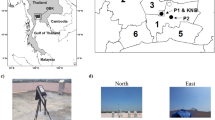Abstract
The present study focused on understanding the factors influencing visibility and its characterization for Indian major cities experiencing varied climate. By analysing historical data of past five years (2016–2020), it is observed that visibility range in tropical wet and dry climate is found to be in the range of 2.92–7.15 km (represented by Kolkata, Bombay, Chennai and Bengaluru), arid steppe or dry climate (Delhi, Ahmedabad) in the range of 2.75 to 4.28 km, temperate dry winter warm summer in the range of 5.48–5.84 km (Coimbatore and Madurai) and 2.72 km in temperate dry winter hot summer (Lucknow). Analysis of the historical weather scenarios (smoke, haze, mist, hail and dust storm/sandstorm) revealed haze contributes significantly on the visibility reduction in Kolkata (72%), Lucknow (65%), Bombay (54%) and Ahmedabad (40%), and smoke is the reason in Ahmedabad (52%) and Bombay (32%). Station ranking based on low visibility events showed the pecking order—Delhi (4245) > Lucknow (1915) > Kolkata (1618) > Bombay (1285) > Chennai (518) > Bengaluru (349) > Ahmedabad (318) > Calicut (251) > Coimbatore (76) > Madurai (35). Haze index calculated for the study regions (after excluding visibility corresponding to relative humidity (RH) > 90% as to eliminate fog events) ranged between 42 and 49 indicating poor visual air quality and poor per cent scene acceptability.








Similar content being viewed by others
References
H. Zhao, H. Che, X. Zhang, Y. Ma, Y. Wang, H. Wang, Y. Wang, Characteristics of visibility and particulate matter (PM) in an urban area of Northeast China. Atmos. Pollut. Res. 4(4), 427–434 (2013). https://doi.org/10.5094/APR.2013.049
US EPA, Guidance for Estimating Natural Visibility Conditions Under the Regional Haze Rule (National Service Center for Environmental Publications, 2003), https://www3.epa.gov/ttn/naaqs/aqmguide/collection/cp2/20030901_oaqps_epa-454_b-03-005_estimating_natural%20_visibility_regional_haze.pdf Accessed 10 July 2023
E. Taylor, A. MacMillan, Air Quality Management: Canadian Perspectives on a Global Issue, (Springer, 2013)
Y. Hu, L. Yao, Z. Cheng, Y. Wang, Long-term atmospheric visibility trends in megacities of China. India and the United States, Environmental Research 159, 466–473 (2017). https://doi.org/10.1016/j.envres.2017.08.018
J. Quan, X. Tie, Q. Zhang, Q. Liu, X. Li, Y. Gao, D. Zhao, Characteristics of heavy aerosol pollution during the 2012–2013 winter in Beijing. China Atmos. Environ. 88, 83–89 (2014). https://doi.org/10.1016/j.atmosenv.2014.01.058
S. Tiwari, S. Payra, M. Mohan, S. Verma, D.S. Bisht, Visibility degradation during foggy period due to anthropogenic urban aerosol at Delhi. India, Atmospheric Pollution Research 2(1), 116–120 (2011). https://doi.org/10.5094/APR.2011.014
M. Lin, J. Tao, C.Y. Chan, J.J. Cao, Z.S. Zhang, L.H. Zhu, R.J. Zhang, Regression Analyses between Recent Air Quality and Visibility Changes in Megacities at Four Haze Regions in China. Aerosol and Air Quality Research 12(6), 1049–1061 (2012). https://doi.org/10.4209/aaqr.2011.11.0220
M.J. Molina, L.T. Molina, Megacities and atmospheric pollution. J. Air Waste Manag. Assoc. 54(6), 644–680 (2004). https://doi.org/10.1080/10473289.2004.10470936
M.C. Peel, B.L. Finlayson, T.A. McMahon, Updated world map of the Koppen-Geiger climate classification. Hydrol. Earth Syst. Sci. 11(5), 1633–1644 (2007). https://doi.org/10.5194/hess-11-1633-2007
S.D. Attri, A. Tyagi, Climate Profile of India (Environment Monitoring and Research Centre, India Meteorological Department, 2010) http://uchai.net/pdf/knowledge_resources/Publications/Reports/Climate%20Profile%20India_IMD.pdf Accessed 10 July 2023
ASOS-AWOS Metar Data, Iowa State University, Iowa Environmental Mesonet https://mesonet.agron.iastate.edu/request/download.phtml?network=IN__ASOS Accessed 10 July 2023
Weatherbase, Browse 41997 cities worldwide, https://www.weatherbase.com/weather/weather-summary Accessed 10 July 2023
S. Sarkar, R. P. Singh and A. Chauhan, Crop residue burning in northern India: Increasing threat to Greater India. Journal of Geophysical Research: Atmospheres (2018), 123. https://doi.org/10.1029/2018JD028428
Lalchandani, V., Srivastava, D., Dave, J., Mishra, S., Tripathi, N., Shukla, A. K. (2022). Effect of biomass burning on PM2.5 composition and secondary aerosol formation during post-monsoon and winter haze episodes in Delhi. Journal of Geophysical Research: Atmospheres, 127, e2021JD035232. https://doi.org/10.1029/2021JD035232
Graham A.M, Pope R.J, Chipperfield M.P, Dhomse S.S, Pimlott M, Feng W, Singh V, Chen Y, Wild O, Sokhi R, Beig G, Quantifying effects of long-range transport of NO2 over Delhi using back-trajectories and satellite data, EGU Sphere, preprint repository https://doi.org/10.5194/egusphere-2023-382, April 2023
Acknowledgements
Authors would like to thank Iowa Environmental Mesonet (IEM) for maintaining automated weather data archive and made it available for researchers.
Funding
No funding was received for conducting this study.
Author information
Authors and Affiliations
Corresponding author
Ethics declarations
Conflict of interest
The authors declare no potential conflict of interest in any form.
Additional information
Publisher's Note
Springer Nature remains neutral with regard to jurisdictional claims in published maps and institutional affiliations.
Rights and permissions
Springer Nature or its licensor (e.g. a society or other partner) holds exclusive rights to this article under a publishing agreement with the author(s) or other rightsholder(s); author self-archiving of the accepted manuscript version of this article is solely governed by the terms of such publishing agreement and applicable law.
About this article
Cite this article
Ulavi, S.U., Saragur Madanayak, S.N. Characterizing Visibility in a Contrasting Climate of Indian Cities. J. Inst. Eng. India Ser. A (2024). https://doi.org/10.1007/s40030-024-00786-5
Received:
Accepted:
Published:
DOI: https://doi.org/10.1007/s40030-024-00786-5




